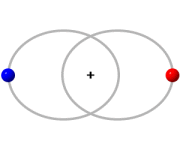PSR 1913 + 16

PSR 1913 + 16 (after its discoverers also Hulse-Taylor pulsar or Hulse-Taylor double pulsar and according to the more recent nomenclature also PSR B1913 + 16 or PSR J1915 + 1606 ) is a pulsar in the constellation of eagle . It is located 21,000 light years away . Its rotation period is just under 17 revolutions per second at 59.03 ms.
Together with another, invisible neutron star , it forms a binary star system . Both stars have the typical mass of a neutron star of 1.4 solar masses (1.4398 the visible pulsar and 1.3886 the invisible companion). They circle the common focus in 7.75 hours. The periastron rotates by 4.2 ° per year, so that - unlike in the schematic drawing - the bodies do not move on closed ellipses , but on a rosette path ( apse rotation ).
The special importance of this star system lies in the fact that its discoverers used the decreasing orbital period for the first time to indirectly detect gravitational waves according to the general theory of relativity , which was honored with the 1993 Nobel Prize in Physics .
Relativistic Effects
Russell Alan Hulse and Joseph Taylor discovered the pulsar PSR 1913 + 16 in 1974 with the Arecibo Observatory . They derived the orbit data of the double star from the observation of periodic time shifts in the pulsar signals . The orbital motion of the great masses allows two predictions of general relativity to be checked.
Time dilation
On the one hand, Hulse and Taylor demonstrated the time dilation that occurs as a result of the increase in mass density in the periastron of both stars: the pulsar's signal slows down by about 1 µs per second (10 −6 ).
Gravitational waves
Secondly, the circulation of the two non-spherical body causes displacement of the mass densities, and the system therefore gravitational energy radiated in the form of gravitational waves. For a long time, only such indirect evidence of gravitational waves existed. It wasn't until 2015 that the LIGO interferometers were used to directly measure a gravitational wave from the collision of two black holes for the first time .
Hulse and Taylor showed, however, that the radiation losses are expressed in a reduction in the distance between the two stars, which in turn has the consequence that the orbital period is reduced; this results from the conservation of angular momentum or Kepler's third law . In 1984 the loss rate was given as - (2.40 ± 0.09) · 10 −12 seconds per second, which corresponds to 99.7 ± 0.2% with the theoretical predictions of general relativity. From the discovery of the pulsar in 1974 to the publication of the data in 1979, the epoch of the periastron decreased by almost 2 seconds, up to 2000 it was almost 30 seconds.
The orbital period is currently decreasing by 76.5 µs per year, with the major semi-axis of the orbits shrinking by 3.5 m. The lifetime of the system until the components fuse is calculated to be 300 million years.
The diagram shows the measured values as points; the line is the prediction of the general theory of relativity for the radiation of gravitational energy - theory and measurements correspond very well.
For this indirect proof of gravitational waves, Hulse and Taylor were awarded the Nobel Prize in Physics in 1993.
With the double black hole discovered in Quasar OJ 287 , there is now a second object on which the emission of gravitational waves can be indirectly detected. Here the relativistic effect with a rotation of the orbit ellipse (periastron rotation ) of 39 ° per revolution is even stronger.
Web links
Individual evidence
- ↑ a b c J. M. Weisberg, DJ Nice, JH Taylor: Timing Measurements of the Relativistic Binary Pulsar PSR B1913 + 16 . In: Astrophysical Journal . 722, 2010, pp. 1030-1034. arxiv : 1011.0718v1 . bibcode : 2010ApJ ... 722.1030W . doi : 10.1088 / 0004-637X / 722/2/1030 .
- ^ A b J. M. Weisberg, JH Taylor, LA Fowler: Gravitational waves from an orbiting pulsar . In: Scientific American . 245, October 1981, pp. 74-82. bibcode : 1981SciAm.245 ... 74W . doi : 10.1038 / scientificamerican1081-74 .
